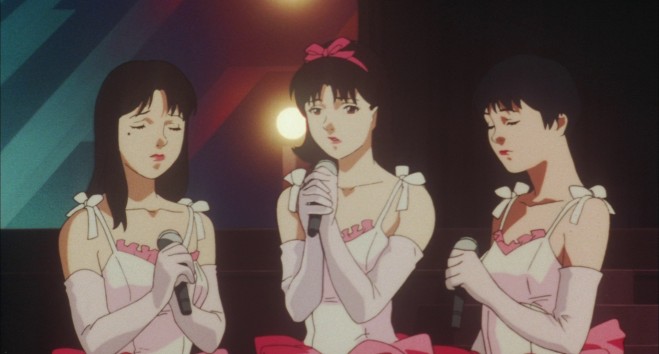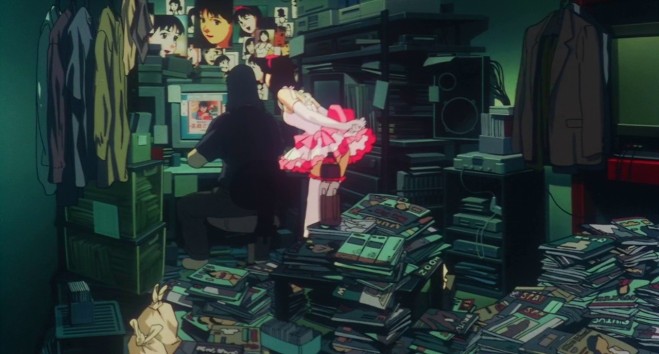
Maybe I was always going to love whatever the next movie I watched after Twilight was, but damn, dude. Damn! I’ve been wanting to check out the works of Satoshi Kon for a long time, particularly Paprika, and now it’s become important I do so once we’re done with Shocktober. At only 87 minutes, Perfect Blue never had a chance to do anything but lock me into its twisted world. Really, the biggest caveat I can think of is that it’s hard to convince other people to watch an anime, even if it’s a stand-alone compl–I mean movie.

In the west, the one thing you’ll hear about Satoshi Kon is that his work was hugely influential on Darren Aronofsky. Aronofsky supposedly bought the rights to Kon’s directorial debut, Perfect Blue, just so he could copy a shot from it in Requiem for a Dream. Years later, Black Swan came out and was essentially an American, live action remake of Perfect Blue. Clearly, Aronofsky likes this movie. But it seems reductive to just talk about Perfect Blue, and Kon’s brief career, as an inspiration for American art. After all, he did it first and maybe did it better too.
Mima (Junko Iwao) is the lead singer of a J-pop trio called CHAM that seems to be just shy of real success. At a somewhat disastrous performance at a festival, Mima announces that she is leaving the band to pursue her career as an actress. This upsets some of her fans and she comes home to an anonymous fax (this is 1997) with “traitor” written all over it. Even more alarmingly, after being taught to use the Internet (again, 1997) Mima finds a website called “Mima’s Room” that is full of detailed diary entries supposedly written by her. She brings this to the attention of one of her managers, fellow ex-pop idol Rumi (Rica Matsumoto), but is told to ignore it.
A crime drama series called “Double Bind” serves as Mima’s first major role, on which she is asked to perform continuously compromising scenes. Around the same time, people involved in Mima’s new career direction start getting murdered. Mima, increasingly traumatized by everything, starts having trouble keeping a hold on reality, and becomes especially paranoid of a stalker that seems to be everywhere. But mostly she has to worry about the other, supernatural version of herself, the one from the online diary. The doppelganger/specter/whatever starts visiting Mima, claiming this new actress version of herself is an imposter and that she is the real one.
Perfect Blue creates horror from discomfort. There are a few scenes of grotesque violence, but most of the time Kon prefers to show you the lead up to and the result of murder, skipping the actual act. Since the story is told almost exclusively from Mima’s point of view, it leans hard into her paranoia, fear, and confusion. By the end of the movie, I was having as hard a time keeping track of what really happened as she was. Maybe harder.
Of course, as anyone who’s seen something like Sunset Boulevard or Mulholland Drive will tell you, the idea of reality is strange for celebrities and their fans, and Perfect Blue delves deep into that. Kon puts us on the stage with CHAM, and it feels super weird to see how much of a farce the whole pop idol thing is. Their bubbly performance is intercut with scenes of Mima grocery shopping, a juxtaposition begging you to ask which one is the real Mima? Could she possibly be both? When she performs a nightmarish rape scene for “Double Bind” she screams in terror, then the director yells cut and she goes blank. The man who was seconds ago ripping her clothes off apologizes for having to hold himself close to her while the crew sets up the next shot. She says not to worry about it.
Adding to this question of reality is the fact that this is an animated film. It doesn’t necessarily have to be, right? I mean, this isn’t Akira, it’s the story of an actress and her career. But animation allows a director total control over what you are seeing, more than you could ever have with real people and places. Kon uses a highly-detailed style, which means there’s rarely much motion on the screen. It’s an acquired taste, but it works: A sexy photo shoot is shown as manipulative and demeaning as those kinds of things are in real life, creepy people appear more like monstrous beings than fellow humans, surreal moments look all the more bizarre in the ways that they move and are colored differently than the rest of the film. Plus, there’s the impossible-to-do-in-real-life editing.
Perfect Blue is a psychological thriller in the tradition of movies like Vertigo and Brazil. Those are films I would comfortably give five stars to, and I’m inclined to put Perfect Blue in that company. Just like those movies, once I got over the visceral thrill of what I had watched, I was left thinking about its critique of celebrity, performance, sexism, and the superficial culture capitalism creates… I’m really glad I got to see this instead of Tetsuo: The Iron Man.


I couldn’t agree with you more. I have to see more of Satoshi Kon’s stuff. His segment, “Magnetic Rose” in the anime anthology film Memories is one of the creepiest and yet most beautiful things I’ve seen. It’s a shame he gone.